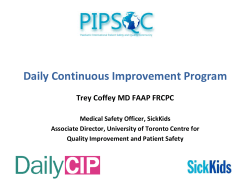
Lean in Healthcare Overview 12-5-14FINAL
Lean in Healthcare John Kim & Associates (JKA) approach to Lean in Healthcare – • • • • • Strategic Goal Alignment (Hoshin Plans) Improved Processes & Performance Lean as a Management System Implementation and Deployment Capability development: Leaders, Managers, Front line workers JKA lean healthcare overview The JKA Lean Healthcare Model is designed to adapt to the needs, culture, and current capabilities of an organization (“one size does not fit all”). Understanding that lean represents a management system designed to provide the processes, tools, and internal capabilities to help leaders lead, managers manage and care teams provide care, the JKA model for Lean in Healthcare encompasses: • Alignment to strategic objectives (Hoshin plans) • Structure to support mobilization, implementation, and deployment of lean as a management system • Culture/people development (executives, directors, managers, supervisors, and staff) Performance Improvement – When applied properly, lean can deliver amazing (and quantifiable) results to an organization. Objectives such as: quality (core measures and outcomes), patient and staff satisfaction (Press Gainey), improved access, and financial performance (revenue, cost). When engaged properly, a lean management system provides: • A process for communicating strategy, objectives, and process performance • A system for front-line problem identification, prioritization, and problem solving • A systemic approach to process improvement and improving performance (i.e., access, quality, satisfaction, utilization, financials, etc.) • A process for knowledge capture and subsequent knowledge sharing across the organization JKA Healthcare Model Results – Understanding these two scenarios provides the keys to defining scope, approach, and complexity of the problem/solution. The first would require a more traditional process improvement approach and the second would require a more analytical approach to data, personalities, and change management. Most healthcare organizations struggle with the implementation and deployment of change and the subsequent sustainment of results. In the JKA model, we focus on the pathways to communicate and message to all affected constituents (RNs, MDs, staff, and leaders). Understanding that a great solution that is poorly deployed is in fact no solution at all is the key to understanding the importance of thoughtful and thorough deployment (i.e., gaining the buy in/confidence in the new process and the delivery and sustainment of results). Understanding whether the process change affects 12 individuals in sterile processing or 212 clinical staff and 57 physicians that support the ICU is key to defining the complexities associated with the implementation and deployment of a solution. • Periop process across 4 hospitals and 30+ specialty practices improving ontime starts from 68% to 84% and increasing OR capacity by 15% • New central line process across 900+ bed hospital reducing Central Line Days by 20% and CLABSI rate by 82% ($4.2mm) • Implementation and deployment of new coding, billing, and charge capture process across 95 clinics, reducing time to bill, denials, and AR days ($3.6mm) ©2015 John Kim and Associates and JKA, LLC All rights reserved (563) 650-3822 www.johnkimconsulting.com Lean in Healthcare Implementation and Deployment – A common failure point in healthcare is the missing link associated with (1) implementation and (2) deployment of change. With the complexity of hospital patient flows, all improvements must have an approach that not only, implements locally (within a unit/department), but also effectively deploys across shifts, units, and other hospitals (and/or physician practices) in the healthcare system. For change (improvement) to be effective and results to be sustained, changes must be: • Captured, messaged, and effectively communicated • Coordinated and implemented (all people affected) • Deployed, measured, and sustained Often this work involves hundreds of individuals (staff, RNs, MDs) across an organization covering multiple shifts, departments, and facilities. Our approach to implementation and deployment actively seeks to capture and effectively share the experiences and improvements developed by a project/lean event team. The ability to capture and message to those who were not on the team is the key to effective implementation and is what enables hospitals and health system to leverage solutions and institutionalize learnings developed at one location across the hospital/system. It is in understanding this approach to knowledge sharing, that organizations eliminate the need to pay for the same improvements over and over again. In the JKA model, knowledge capture and knowledge transfer are active components of the learning cycle and form the foundation for implementing, deploying, and sharing improvements from one area, department or clinic to other floors, facilities, and departments. People and Culture – Fundamentals such as: a) senior leadership roles and responsibilities, b) development of leaders and leadership thinking (e.g., Managing for Daily Improvement), c) internal development of problem identification, prioritization, and problem solving skills (e.g., A3 thinking, PDSA cycle), d) an infrastructure which supports knowledge capture and knowledge transfer are all key factors impacting the effectiveness of any management system. More so than driving process and performance improvement, the investment and development in executives, directors, • • • • Key Components – Lean in Healthcare Leadership Development – Lean as a Management System includes the development of senior leaders, directors, managers, and supervisors in both performance management (dashboards, MDI, A3, Gemba walks) and process improvement. Process Improvement – Performance Improvement through the fundamental improvement of key processes is a core competency to be developed in any health system, hospital, medical group, and/or health plan. Lean Infrastructure – Having the processes and systems in place to not only lead and guide the appropriate selection and execution of process improvement activities, but more importantly to effectively document, spread, and scale solutions across departments, units, and locations is key to speed to value. People Development – At its most basic level, we view lean as a people development process. Focusing not only on process improvement and results, but on the continual support and development of thinkers and learners throughout an organization. ©2015 John Kim and Associates and JKA, LLC All rights reserved (563) 650-3822 www.johnkimconsulting.com
© Copyright 2025












